Selectors allow you to filter and customize the Views of your Boards and widgets in Pigment. This article details how to configure and adjust selectors to enhance the context and user experience of your Views and Boards.
How can Members adjust selectors?
The most common way for a Member to adjust the context of their Boards is by using the selector dropdown menus in the top-left corner of the Board or through a widget’s selector options.
Members can adjust selectors in two additional ways.
1. Use headers in Tables and Metrics
When working with Boards, you can change a selector by right-clicking on a Dimension Item within a header and selecting Set as Page.
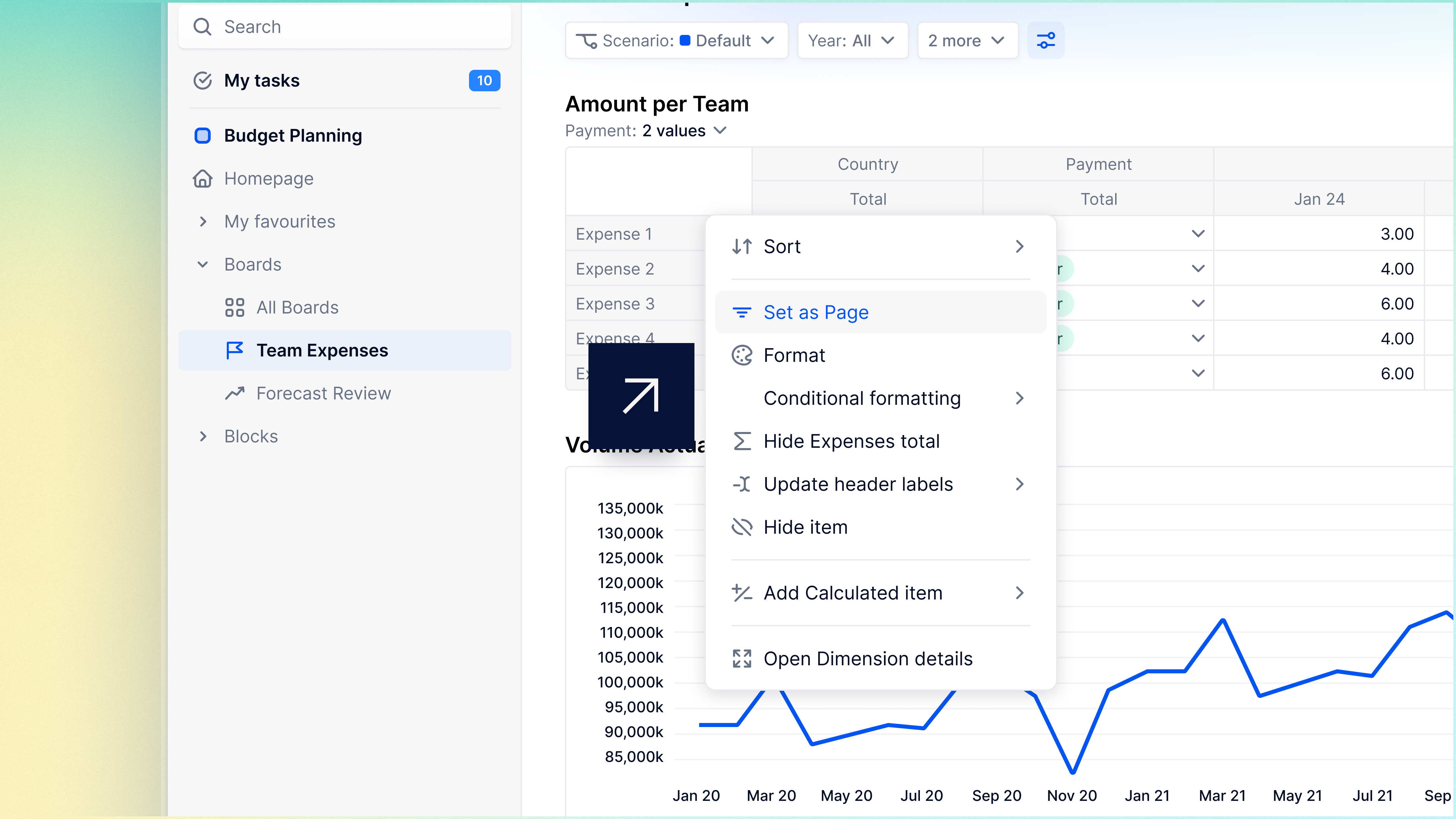
2. Use Charts
If a Dimension is used as a selector and is also displayed on the chart, you can select any Item from the chart and use Set as Page to make it the selector. If the chart includes multiple Dimensions as selectors, the action will apply to all of them.
How do Builders configure selector options?
To define selector options, the Pages section in your Configure Data panel must contain a Dimension.
Builders can configure selector options in the following ways.
On a Board
To configure selectors on a Board:
- Select Edit.
- Use the Selector Options icon that appears to the right of the available selectors to view and manage options.
- Select Done.
In a Widget
To configure selectors in a widget:
- Select Edit, then go to Settings.
- Use Edit next to Selectors to view and manage the available options.
In a Block
To configure selectors in a Block:
- Use the Selector Options icon located to the right of the available selectors.
Working with selector options
You can adjust selectors fit the context of your Board in a variety of ways.
Reorder selectors
You can drag and drop selectors in the Selectors options panel to reorder them at Board level. New selectors are added to the end of the list by default but can be rearranged to fit your preferences. To control the selector order within a widget, adjust the order in the Pivot of the saved View.
Rename selectors
You can rename selectors at the Board level. When you rename a selector on a Board, the change is applied across the entire Board, including all widgets using that selector. However, the update does not affect other Boards in your Workspace or widgets where the selector has been unlinked.
To rename a selector at the Board level:
- Open your Board and select Edit, then click the Selector Options icon.
- Locate the selector you want to rename.
- Click the Rename icon next to the selector’s name.
- Enter the new name for the selector.
- Select Apply to save your changes.
- (Optional) To reset the selector to its original name, click the X icon.
Single & Multi Selectors
The first step to configuring your selector options is to decide if it should be a single or multi selection type.
- When you use a single selector, only one Item within that Dimension is available to view. For example, when FY22 is selected, you only see data for FY22.
- When you use a multi selector, you have the option to view one Item, similar to a single Page, or to view combined Items in a View. When you select multiple values, Pigment combines those values based on the Metric’s selection in the Aggregator panel.
The initial selection will be determined by the default selector type but this can be changed. The default selector type only impacts newly created Views.
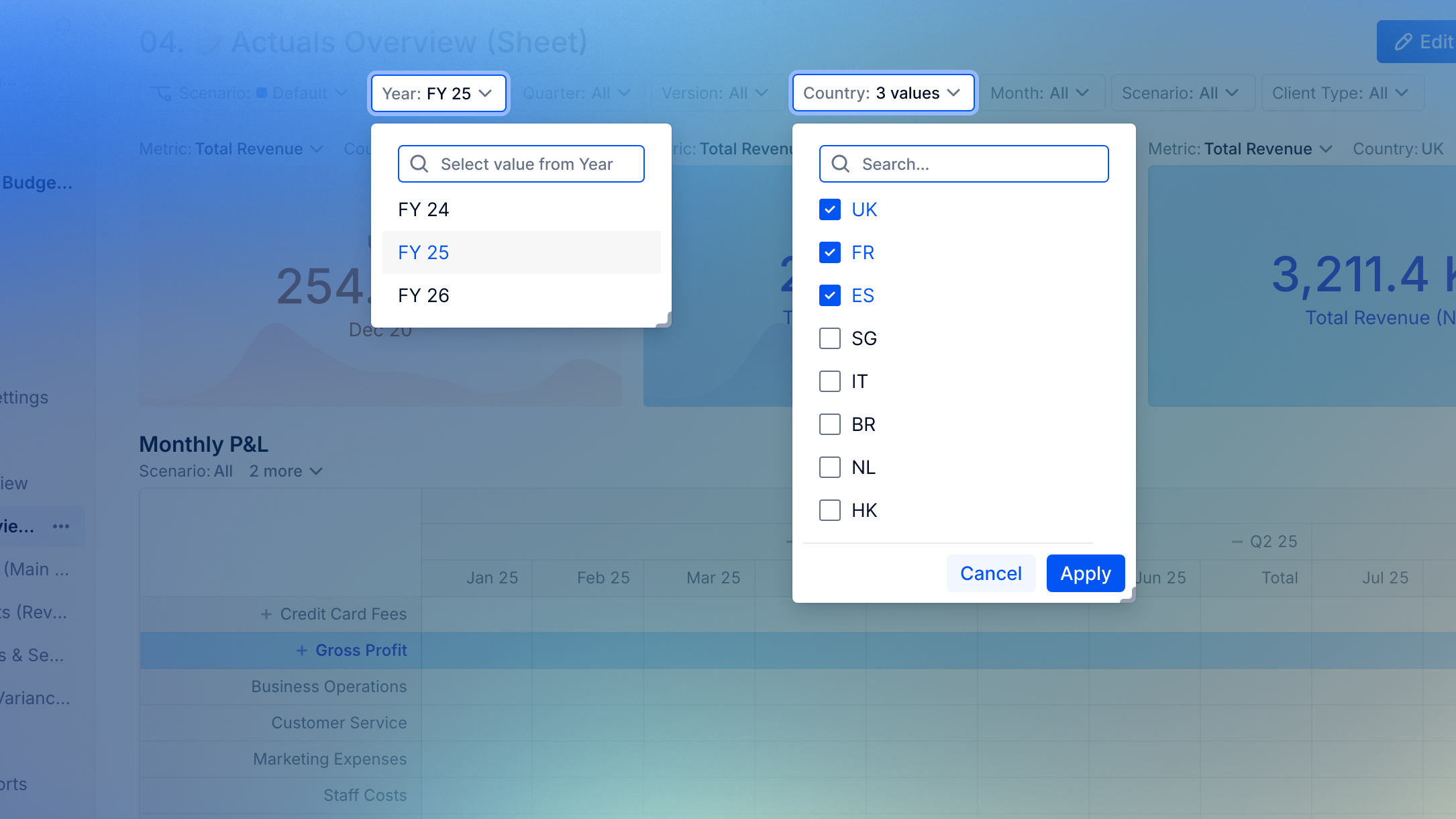
Available Items
You can control which Items are available for Members to select by using the Available Items menu. This helps limit the number of options for a user. For example, if your list has data for only a few Items, you can limit the selection to those Items only. All Variable types can be used as Available Items. For more information, see Item Variables.
Security
Available Items should not be used for security purposes. They are only intended to limit the selection, helping Members quickly find the Items they need. Depending on permission settings for Configure Views and/or Configure Boards, this setting can be adjusted, making more or less Items available as required.
Adaptive Display
Adaptive Display controls the Items appearing in the selector dropdown based on various factors. This ranges from predefined available Items to dependency on other Page selections or Item availability. Their options can be set at the Board or widget level.
All available Items shows the Items set in Available Items. Dependent Page selections adjusts to Parent Page selections, allowing you to limit options based on another Page selector. Dynamic selection uses the same functionality of Dependent Page selections but it also filters out blank cells, only showing Items when data is present for that Item. For more information on Adaptive Display, see Adaptive Display Controls in Page Selectors.
Display Mode
Display Mode allows you to control the visibility of selectors in Boards and widgets. You can show, hide or minimize a selector. When hidden, a selector will not appear on the Board. Minimize consolidates selectors in a menu that Members can click on to access all minimized selectors. For more information on Display Mode, see Hide and Minimize Board and Widget Page Selectors in Display Mode.
Blue vs black color selectors
Selectors by default are black, when you change the selector to a different value the color changes to blue and persists for your entire Pigment session.
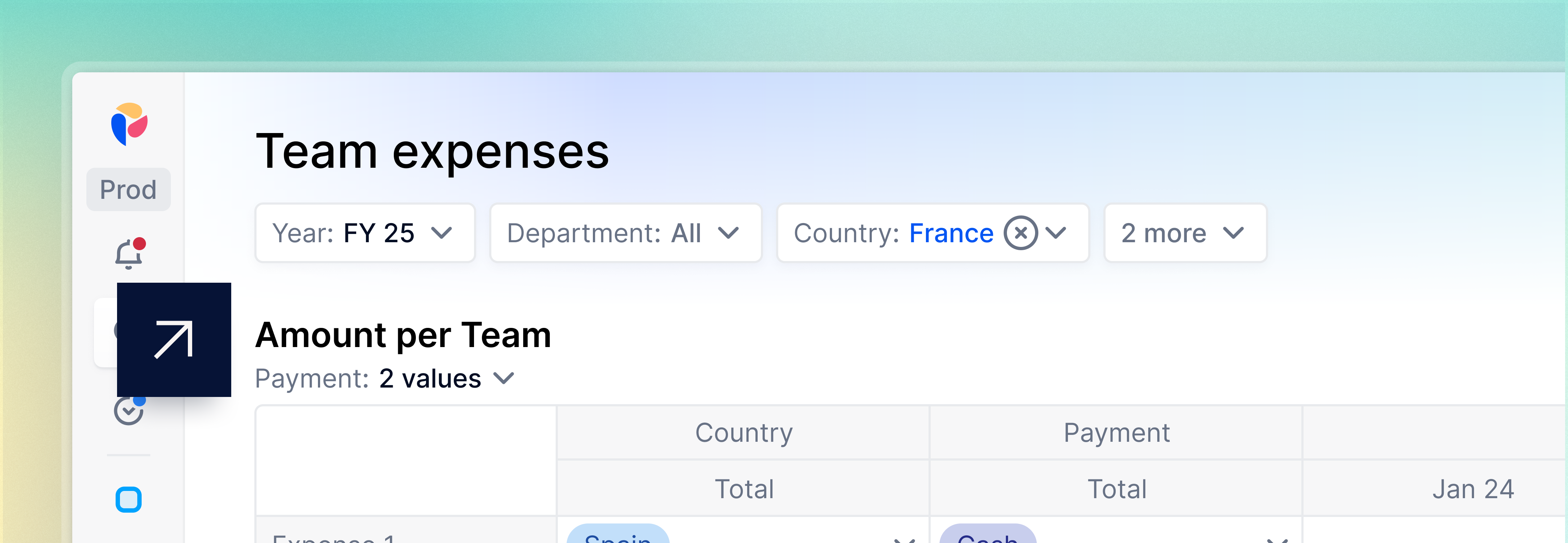
Reset selectors
You can clear the selections on an individual selector on the Board by clicking the X icon next to it. This option resets the selector to its preset options. You can also reset all selections by clicking Reset in the top-right corner of the Selector options panel. This can be done at widget or Board level.
Resize Page selectors
You can adjust your Page selector on the Board to view the full name of your Dimension Items. Use the handle in the bottom-right corner of the selector to adjust as required. This can be done at Board, widget, or Block level in full-screen mode.
Default Items
Default Items define the Items that appear when a Board or Block is opened. Members can still adjust the selector but it returns to its default setting when it is closed and reopened. This setting works on both multi and single selector options. All types of Variables can be selected as Default Items. For more information, see Item Variables.
Widget selector options
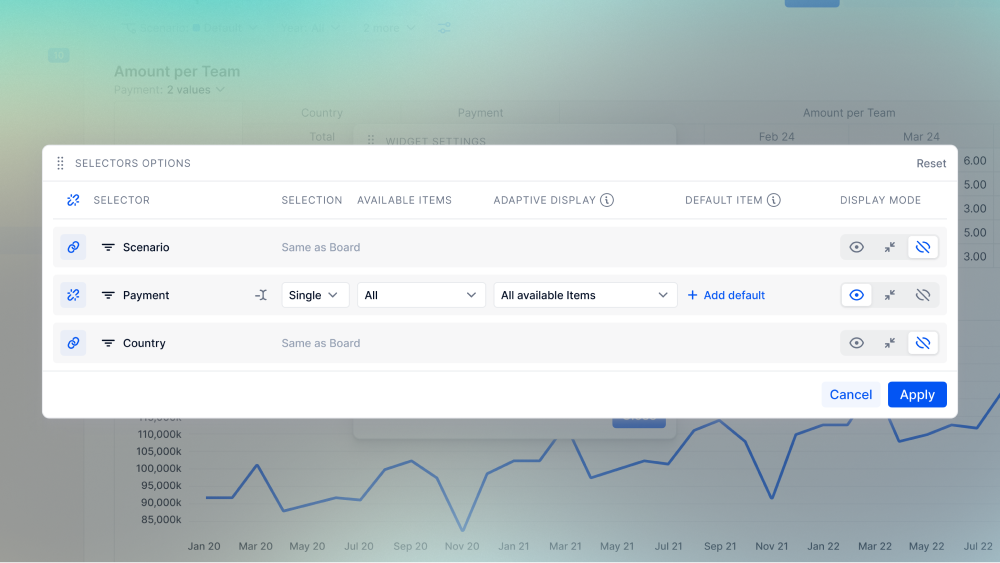
Link and adjust selectors
When working with widgets on a Board, you can adjust the selector options for each individual widget from the Widget Settings panel.
In Selector options, you’ll see a link icon next to each selector available within the widget. When linked, the widget’s selector syncs with the selectors located at the top of the Board.
For example, if your Board’s Country selector is set to France, all other widgets with a Country selector will sync to France.
If you unlink a Page selector, you can customize its options within the widget. This includes:
- Setting a different Selection type
- Adjusting Available Items
- Enabling Adaptive Display
- Defining Default Items
Additionally, you can adjust the Display Mode for both linked and unlinked selectors.
To adjust a selector for a widget:
- Select Edit in the top-right corner of the Board.
- Select Settings on the widget.
- In the Widget Settings panel, go to Selectors and select Edit.
- Adjust the selectors as needed and select Apply.
- Select Done.
Customizing these options enhances the context and user experience of your Board. For more tips on Board design, see Board Inspiration (including top tips for Board design).
How Variable and Page selectors work together
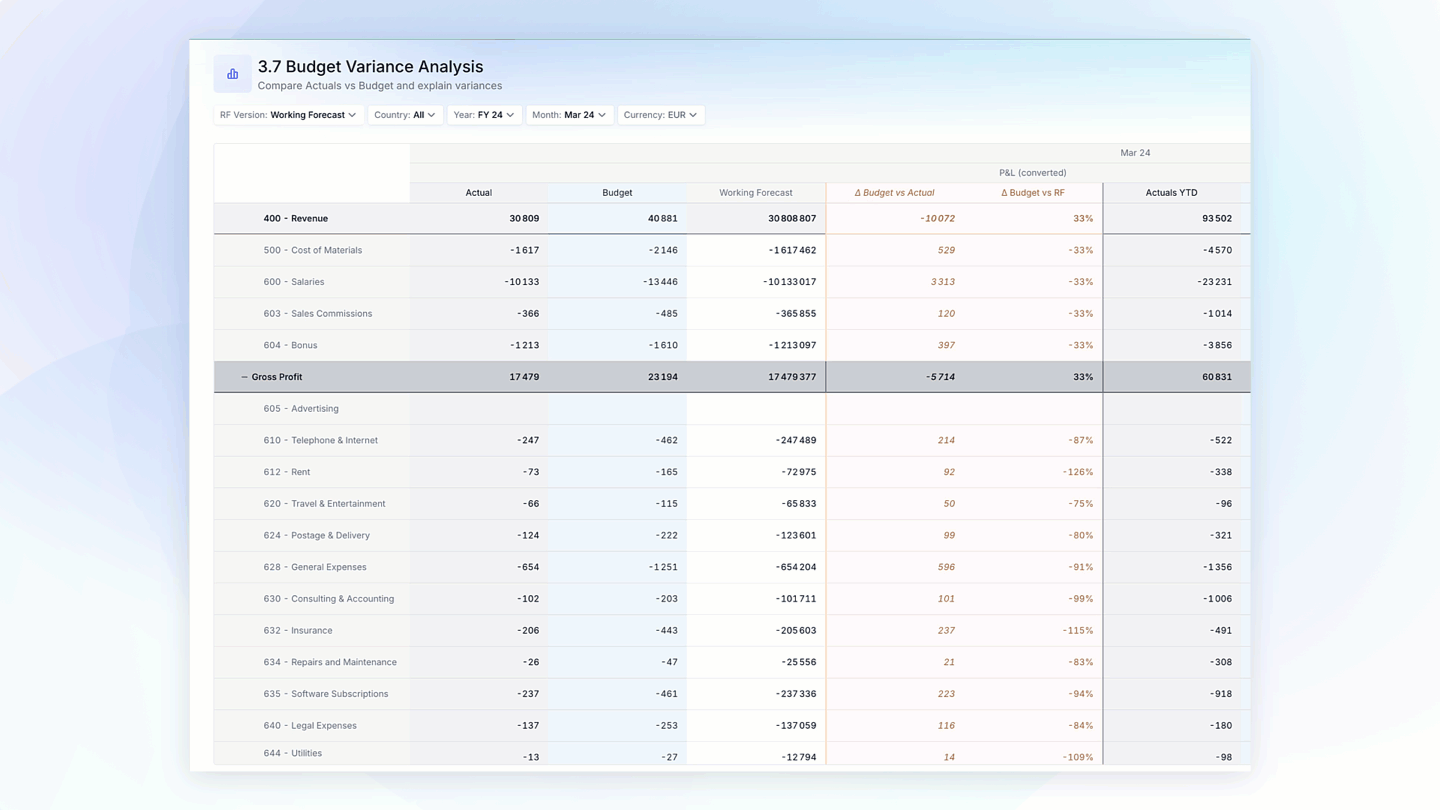
Selectors group together Variable and Page selectors. When working with Variables in Pigment, there’s an additional option available to allow value changes directly on the Variable. When activated, a separate selector displays in your Block, next to the Page selectors, and on any Board where the Metric is used.
This selector lists all the Dimension Items that the Variable is linked to, just like a Page selector of that Dimension, and is always displayed as a single selector. The default value for the selector is set to the default Variable value of the Variable.
This selector can be customized from the Selector options panel, where you can also customize Page selectors. Here you can rename, reorder, hide, or minimize the Variable values selector as you would do with Page selectors. The available Items for the Variables can be restricted, just like for any Page selector. However, unlike Page selectors, Adaptive Display does not apply to Variable selectors.
In a Board, Variable selectors are automatically linked to their original widgets. They appear in the widget's selector options and in a widget’s full screen mode. They function similarly to Page selectors; if linked at the widget level, they retain the Board’s configuration.
To ensure Members only see the Variable selector, it’s recommended that you reference Variables in the Default or Available Items (or both) of Page selectors, and then hide the corresponding Page selectors.
When using Variable Selectors, the selected value applies only to the Member who makes the selection and does not impact other Members.
For more information on how to create a Variable with this option enabled, see Item Variables.
